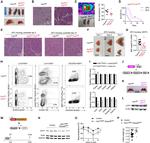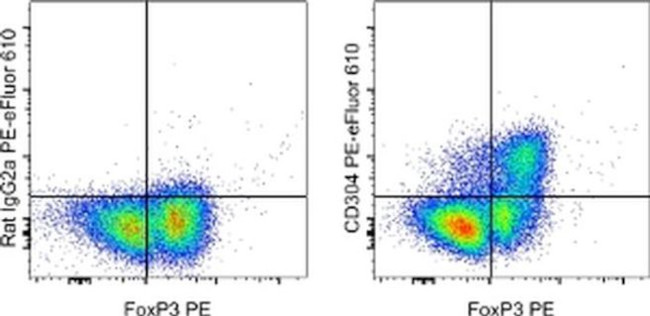Search Thermo Fisher Scientific
Invitrogen
CD304 (Neuropilin-1) Monoclonal Antibody (3DS304M), PE-eFluor™ 610, eBioscience™
FIGURE: 1 / 2
CD304 (Neuropilin-1) Antibody (61-3041-82) in Flow


Product Details
61-3041-82
Species Reactivity
Published species
Host/Isotype
Recommended Isotype Control
Class
Type
Clone
Conjugate
Excitation/Emission Max
Form
Concentration
Purification
Storage buffer
Contains
Storage conditions
Shipping conditions
RRID
Product Specific Information
Description: The monoclonal antibody 3DS304M recognizes mouse CD304 (Neuropilin-1), a type 1 transmembrane glycoprotein present on the surface of multiple cell types, including: regulatory T cells (Treg), NKT cells, DC, certain types of stem cells, neurons, endothelial cells, and some neoplastic cells. Neuropilin-1, in complex with plexins, serves as a co-receptor for type 3 semaphorins in growing neurons. It is also involved in the process of angiogenesis being a part of a functional receptor for VEGF in endothelial cells. In mice, Neuropilin-1 is expressed on thymus-derived natural Treg but not peripherally induced Treg. In addition, transient expression on recently activated non-regulatory T cells has been observed. Neuropilin-1 has been used as a marker of recent thymic emigrants in the mouse iNKT cell population. It has been shown that Neuropilin-1 forms a complex with TGF beta receptors, activating the latent form of TGF beta (LAP-TGF beta 1) and augmenting canonical Smad2/3 signaling.
This 3DS304M antibody will recognize formaldehyde-fixed as well as methanol-treated epitopes.
Applications Reported: This 3DS304M antibody has been reported for use in intracellular staining followed by flow cytometric analysis.
Applications Tested: This 3DS304M antibody has been tested by intracellular staining and flow cytometric analysis of mouse splenocytes using the Foxp3/Transcription Factor Staining Buffer Set (Product # 00-5523-00) and protocol. Please refer to Best Protocols: Protocol B: One step protocol for (nuclear) intracellular proteins located under the Resources Tab online. This can be used at less than or equal to 0.5 µg per test. A test is defined as the amount (µg) of antibody that will stain a cell sample in a final volume of 100 µL. Cell number should be determined empirically but can range from 10^5 to 10^8 cells/test. It is recommended that the antibody be carefully titrated for optimal performance in the assay of interest.
PE-eFluor® 610 can be excited with laser lines from 488-561 nm and emits at 607 nm. We recommend using a 610/20 band pass filter (equivalent to PE-Texas Red®). Please make sure that your instrument is capable of detecting this fluorochome.
Light sensitivity: This tandem dye is sensitive to photo-induced oxidation. Please protect this vial and stained samples from light.
Fixation: Samples can be stored in IC Fixation Buffer (Product # 00-8222) (100 µL of cell sample + 100 µL of IC Fixation Buffer) or 1-step Fix/Lyse Solution (Product # 00-5333) for up to 3 days in the dark at 4°C with minimal impact on brightness and FRET efficiency/compensation. Some generalizations regarding fluorophore performance after fixation can be made, but clone specific performance should be determined empirically.
Excitation: 488-561 nm; Emission: 607 nm; Laser: Blue Laser, Green Laser, Yellow-Green Laser.
Filtration: 0.2 µm post-manufacturing filtered.
Target Information
Neuropilin 1 is a 923 amino acid containing membrane bound coreceptor to a tyrosine kinase receptor belonging to the neuropilin family with two CUB domains, two F5/8 type C domains and a MAM domain. Neuropilin 1 forms a heterodimer with NRP2 (Neuropilin 2) and is known to bind to plexin (PLXNB1) to form semaphorin receptors. Expressed mostly in the nervous system this receptor is implicated in a wide range of functions including in the development of the cardiovascular system, angiogenesis, repulsive axon guidance, formation of certain neuronal circuits, cell survival, control of neuronal migration and organogenesis outside the nervous system. This semaphorin receptor functions as receptors for both the semaphorins and vascular endothelial growth factor and is also a regulator of VEGF-induced angiogenesis. Neuropilin 1 may be involved in aggressive advanced prostate carcinoma and in the progression of breast cancer.
For Research Use Only. Not for use in diagnostic procedures. Not for resale without express authorization.
How to use the Panel Builder
Watch the video to learn how to use the Invitrogen Flow Cytometry Panel Builder to build your next flow cytometry panel in 5 easy steps.
Bioinformatics
Protein Aliases: A5 protein; CD304; Neuropilin; Neuropilin-1; Neuropilin-1 precursor (A5 protein); Neuropilin1; NRP 1; sNRP 1; sNRP1; soluble NRP 1; soluble NRP1; transmembrane receptor
Gene Aliases: C530029I03; NP-1; NPN-1; Npn1; Nrp; Nrp1
UniProt ID: (Mouse) P97333
Entrez Gene ID: (Mouse) 18186

Performance Guarantee
If an Invitrogen™ antibody doesn't perform as described on our website or datasheet,we'll replace the product at no cost to you, or provide you with a credit for a future purchase.*
Learn more
We're here to help
Get expert recommendations for common problems or connect directly with an on staff expert for technical assistance related to applications, equipment and general product use.
Contact tech support

